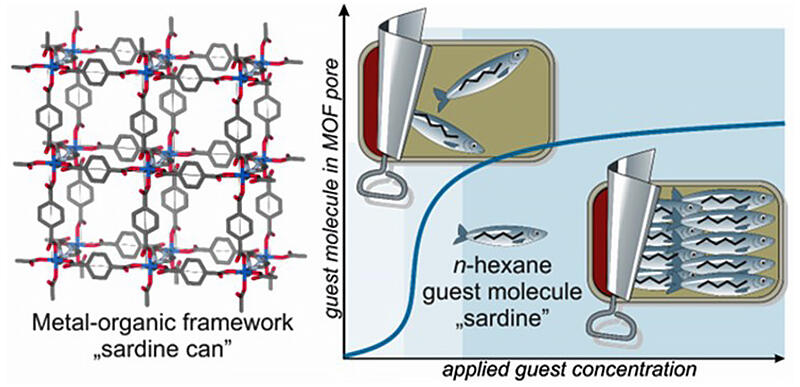A group led by graduate student Risa Mashita, Associate Professor Kenji Okada, Assistant Professor Arisa Fukatsu, researcher Bettina Baumgartner and Professor Masahide Takahashi of the Graduate School of Engineering, Osaka Metropolitan University, has successfully observed how molecules are packed into porous materials in real time.
Porous materials with a large number of nano- to meso-sized pores (about 1-50 nanometers) have a large surface area per unit mass and are key to realizing a recycling-oriented society by removing environmentally harmful substances (gases such as volatile organic compounds (VOCs) and carbon dioxide) and as catalysts in the synthesis of materials. They are also widely known for their role in the removal of radioactive materials in nuclear power plant accidents. Among porous materials, metal-organic frameworks (MOF) are drawing attention as the next generation of porous materials because of their regularly aligned nanopores of uniform size and extremely large surface area (some exhibit a surface area of a soccer field in a single gram). However, the way molecules enter MOF pores and their arrangement requires large-scale experiments using synchrotron radiation facilities, and it is very difficult to analyze experimentally, which has been a challenge in the realization of highly efficient separation and catalytic porous materials.
The research group focused on the fact that molecules in pores can be easily and efficiently detected by infrared absorption spectroscopy and has previously reported that the orientation of molecules in porous materials can be detected by using polarized infrared light. By combining polarization-dependent infrared spectroscopy with the molecular absorption method, they have developed a new method to obtain information on the real-time absorption of molecules into nanopores and their arrangement and orientation in the pores.
Using a general-purpose infrared spectrometer with a simple attachment, fabricated with a 3D printer, the researchers succeeded in precisely detecting in real time the entry of molecules into a MOF and their orientation and location within the pores.
The results demonstrated the "sardine can" effect (in which molecules are oriented in the same direction and regularly lined up to make effective use of nanospace, just like sardines are aligned in a can) when the molecules are packed into narrow pores.

Provided by OMU
The research reveals how molecules are packed into nano-sized pores in an orderly arrangement sequence, which is hoped to contribute to selective removal and the development of superior catalysts targeting only house dust and other harmful substances that cause air pollution.
"In the past, large-scale experiments at synchrotron radiation facilities such as SPring-8 were required to reveal the behavior of molecules in nanopores, but now, by using attachments fabricated by a 3D printer, it is now possible to monitor molecular absorption in the laboratory and in the field in real time by extending a simple, low-cost, general-purpose infrared spectroscopy system," says Professor Takahashi. "We hope this will contribute to the development of porous materials used for environmental protection and purification as well as catalysts, thereby further accelerating the shift to a sustainable society."
Volatile Organic Compounds (VOC): a generic term for organic chemical substances that readily evaporate into the atmosphere at room temperature and pressure. VOCs include toluene, benzene, CFCs and dichloromethane.
Journal Information
Publication: Angewandte Chemie
Title: Guest Alignment and Defect Formation during Pore Filling in Metal-Organic Framework Films
DOI: 10.1002/anie.202201725
This article has been translated by JST with permission from The Science News Ltd.(https://sci-news.co.jp/). Unauthorized reproduction of the article and photographs is prohibited.




